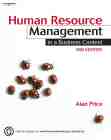Adapted from Chapter 2 of Human Resource Management in a Business Context, 2nd edition. Copyright © 1997-2006 Alan Price 2004.
"We must commit ourselves to 'wrestling' with this stakeholder stuff." say Steven F. Walker
and Jeffrey W. Marr in Stakeholder Power: A Winning Plan for Building Stakeholder Commitment
and Driving Corporate Growth (2001). "Only a brave leader explores what the troops really think.
... But to be a true leader in the new economy, we must earn the trust of all our key stakeholders by learning to place faith in people and by weighing
their needs and opinions into our business decisions. If we as managers use tools to listen to
them, then collaborate with them fairly and intelligently, we will take care of the business
and its constituents and, as a result, take care of ourselves as well."
It is a fairly obvious truism that a wide range of people and interest groups have an
involvement with any organization - including stock/shareholders, customers, suppliers, employees,
the local community, government and others. Clearly, they also have different and varying degrees
of influence on the conduct and progress of the organization. There is a cultural context: the
American stockholder approach contrasts strongly with the continental European or Japanese. The US
approach (mirrored to some extent in countries like Australia, Canada, New Zealand, South Africa and the UK)
places power (and reward) in the hands of the stockholder. Acording to Windsor (1998):
"Stakeholder theory is a critique of the strong stockholder doctrine in U.S. corporation law
and financial-economics theory positing that management's clear fiduciary responsibility is to
maximize economic rents on behalf of the firm's legal owners (the residual claimants). Strong
stockholder doctrine was articulated in Dodge Brothers v. Ford (1919), in which the Michigan
Supreme Court ordered Ford Motor Co. to pay a special dividend." In the stockholder model, other
stakeholders - particularly employees - do not count.
But Marr and Walker (2001) contend that: "It is always a mistake to operate as if employees
are dispensable or easily interchangeable, because they are not. By definition, we cannot have
an organization without the right employees -- people who fit our cultures, who bring the right
combination of talent, experience, and personality to our organizations. These people are never
easily replaced. Further, how humanely they are treated when they leave has a lasting impact on
those who stay. It certainly sends a clear message about the company's commitment to workers."
You might think that stakeholder theory has its origins in HRM. Certainly Beer et al
(1984)'s makes
considerable use of the concept. But the main protagonist is regarded as being R. Edward Freeman,
Olsson Professor of Applied Ethics at the University of Virginia's Darden School. He argued that
managers should serve the interests of everyone with a "stake" in (that is, affect or are
affected by) the firm. Stakeholders include shareholders, employees, suppliers, customers, and
the communities in which the firm operates - termed by Freeman the "big five." According to
Freeman the purpose of the firm is to serve and coordinate the interests of its various
stakeholders. The firm's managers are morally obliged to strike an appropriate
balance among the big five interests when directing the firm's activities.
>

